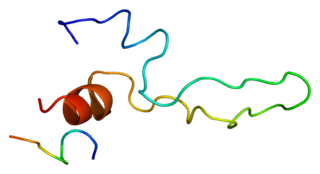
Cholecystokinin is a peptide hormone of the gastrointestinal system responsible for stimulating the digestion of fat and protein. Cholecystokinin, formerly called pancreozymin, is synthesized and secreted by enteroendocrine cells in the duodenum, the first segment of the small intestine. Its presence causes the release of digestive enzymes and bile from the pancreas and gallbladder, respectively, and also acts as a hunger suppressant.
Cholecystokinin receptors or CCK receptors are a group of G-protein coupled receptors which bind the peptide hormones cholecystokinin (CCK) and gastrin. There are two different subtypes CCKA and CCKB which are ~50% homologous: Various cholecystokinin antagonists have been developed and are used in research, although the only drug of this class that has been widely marketed to date is the anti-ulcer drug proglumide.

Dizocilpine (INN), also known as MK-801, is a pore blocker of the N-Methyl-D-aspartate (NMDA) receptor, a glutamate receptor, discovered by a team at Merck in 1982. Glutamate is the brain's primary excitatory neurotransmitter. The channel is normally blocked with a magnesium ion and requires depolarization of the neuron to remove the magnesium and allow the glutamate to open the channel, causing an influx of calcium, which then leads to subsequent depolarization. Dizocilpine binds inside the ion channel of the receptor at several of PCP's binding sites thus preventing the flow of ions, including calcium (Ca2+), through the channel. Dizocilpine blocks NMDA receptors in a use- and voltage-dependent manner, since the channel must open for the drug to bind inside it. The drug acts as a potent anti-convulsant and probably has dissociative anesthetic properties, but it is not used clinically for this purpose because of the discovery of brain lesions, called Olney's lesions (see below), in laboratory rats. Dizocilpine is also associated with a number of negative side effects, including cognitive disruption and psychotic-spectrum reactions. It inhibits the induction of long term potentiation and has been found to impair the acquisition of difficult, but not easy, learning tasks in rats and primates. Because of these effects of dizocilpine, the NMDA receptor pore blocker ketamine is used instead as a dissociative anesthetic in human medical procedures. While ketamine may also trigger temporary psychosis in certain individuals, its short half-life and lower potency make it a much safer clinical option. However, dizocilpine is the most frequently used uncompetitive NMDA receptor antagonist in animal models to mimic psychosis for experimental purposes.

Opioid peptides are peptides that bind to opioid receptors in the brain; opiates and opioids mimic the effect of these peptides. Such peptides may be produced by the body itself, for example endorphins. The effects of these peptides vary, but they all resemble those of opiates. Brain opioid peptide systems are known to play an important role in motivation, emotion, attachment behaviour, the response to stress and pain, control of food intake, and the rewarding effects of alcohol and nicotine.

Met-enkephalin, also known as metenkefalin (INN), sometimes referred to as opioid growth factor (OGF), is a naturally occurring, endogenous opioid peptide that has opioid effects of a relatively short duration. It is one of the two forms of enkephalin, the other being leu-enkephalin. The enkephalins are considered to be the primary endogenous ligands of the δ-opioid receptor, due to their high potency and selectivity for the site over the other endogenous opioids.

The nociceptin opioid peptide receptor (NOP), also known as the nociceptin/orphanin FQ (N/OFQ) receptor or kappa-type 3 opioid receptor, is a protein that in humans is encoded by the OPRL1 gene. The nociceptin receptor is a member of the opioid subfamily of G protein-coupled receptors whose natural ligand is the 17 amino acid neuropeptide known as nociceptin (N/OFQ). This receptor is involved in the regulation of numerous brain activities, particularly instinctive and emotional behaviors. Antagonists targeting NOP are under investigation for their role as treatments for depression and Parkinson's disease, whereas NOP agonists have been shown to act as powerful, non-addictive painkillers in non-human primates.

TRIMU-5 is a selective agonist of the μ2-opioid receptor and antagonist of the μ1-opioid receptor. It produces analgesia in animals that differs from that of conventional μ-opioid receptor agonists but that can still be blocked by μ-opioid receptor antagonists. TRIMU-5 can also block the analgesic effects of μ-opioid receptor agonists like morphine. In addition to analgesia, TRIMU-5 inhibits gastrointestinal transit, a known effect of μ2-opioid receptor activation.

The cholecystokinin B receptor also known as CCKBR or CCK2 is a protein that in humans is encoded by the CCKBR gene.

The Cholecystokinin A receptor is a human protein, also known as CCKAR or CCK1, with CCK1 now being the IUPHAR-recommended name.

Proglumide (Milid) is a drug that inhibits gastrointestinal motility and reduces gastric secretions. It acts as a cholecystokinin antagonist, which blocks both the CCKA and CCKB subtypes. It was used mainly in the treatment of stomach ulcers, although it has now been largely replaced by newer drugs for this application.
DAMGO is a synthetic opioid peptide with high μ-opioid receptor specificity. It was synthesized as a biologically stable analog of δ-opioid receptor-preferring endogenous opioids, leu- and met-enkephalin. Structures of DAMGO bound to the µ opioid receptor reveal a very similar binding pose to morphinans.
A cholecystokinin receptor antagonist is a specific type of receptor antagonist which blocks the receptor sites for the peptide hormone cholecystokinin (CCK).

RB-101 is a drug that acts as an enkephalinase inhibitor, which is used in scientific research.

Cholecystokinin tetrapeptide (CCK-4, tetragastrin, Trp-Met-Asp-Phe-NH2) is a peptide fragment derived from the larger peptide hormone cholecystokinin. Unlike cholecystokin which has a variety of roles in the gastrointestinal system as well as central nervous system effects, CCK-4 acts primarily in the brain as an anxiogenic, although it does retain some GI effects, but not as much as CCK-8 or the full length polypeptide CCK-58.

Lorglumide (CR-1409) is a drug which inhibits gastrointestinal motility and reduces gastric secretions, acting as a cholecystokinin antagonist, with fairly high selectivity for the CCKA subtype. It has been suggested as a potential treatment for a variety of gastrointestinal problems including stomach ulcers, irritable bowel syndrome, dyspepsia, constipation and pancreatitis, as well as some forms of cancer, but animal and human testing has produced inconsistent results and no clear therapeutic role has been established, although it is widely used in scientific research.

Devazepide is benzodiazepine drug, but with quite different actions from most benzodiazepines, lacking affinity for GABAA receptors and instead acting as an CCKA receptor antagonist. It increases appetite and accelerates gastric emptying, and has been suggested as a potential treatment for a variety of gastrointestinal problems including dyspepsia, gastroparesis and gastric reflux. It is also widely used in scientific research into the CCKA receptor.

Dexloxiglumide is a drug which acts as a cholecystokinin antagonist, selective for the CCKA subtype. It inhibits gastrointestinal motility and reduces gastric secretions, and despite older selective CCKA antagonists such as lorglumide and devazepide having had only limited success in trials and ultimately never making it into clinical use, dexloxiglumide is being investigated as a potential treatment for a variety of gastrointestinal problems including irritable bowel syndrome, dyspepsia, constipation and pancreatitis, and has had moderate success so far although trials are still ongoing.

Kelatorphan is a drug which acts as a powerful and complete inhibitor of nearly all of the enzymes responsible for catabolism of the endogenous enkephalins, including neutral endopeptidase (NEP), dipeptidyl peptidase III (DPP3), aminopeptidase N (APN), and angiotensin-converting enzyme (ACE). In mice, with the intracerebroventricular co-administration of a 50 µg dose of kelatorphan (this route is necessary because kelatorphan is incapable of crossing the blood-brain-barrier) hence alongside exogenous [Met]enkephalin (ED50 approximately 10 ng), it potentiated the analgesic effects of the latter by 50,000 times. Kelatorphan also displays potent antinociceptive effects alone, and does not depress respiration, although at high doses it actually increases it.
Jean-Charles Schwartz, born on May 28, 1936, in Paris, is a French neurobiologist, pharmacist and researcher. Husband of Ketty Schwartz, née Gersen (1937-2007) and father of Olivier, Marc and Emmanuelle. He is a member of the Academy of Sciences.. He developed pitolisant, the first clinically approved antagonist for H3 receptors.

LY-235959 is a competitive antagonist at the NMDA receptor. It has analgesic and neuroprotective effects and causes hypothermia in animal models, as well as reducing the development of tolerance to morphine and altering the reinforcing effects of cocaine.
















